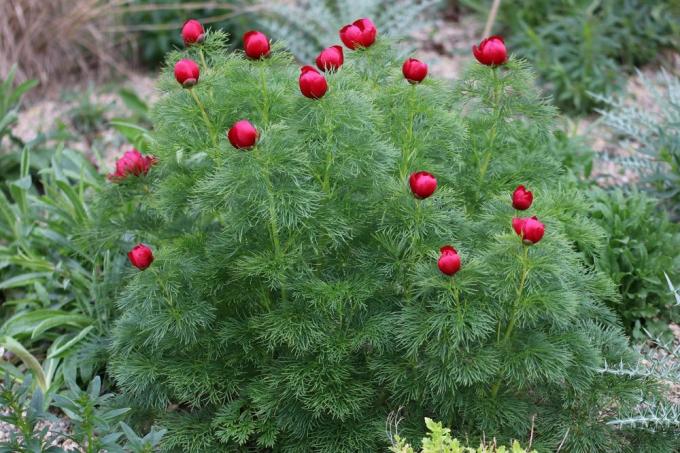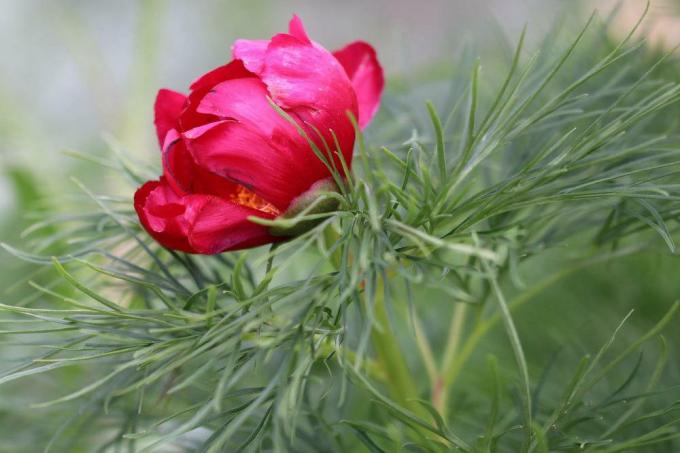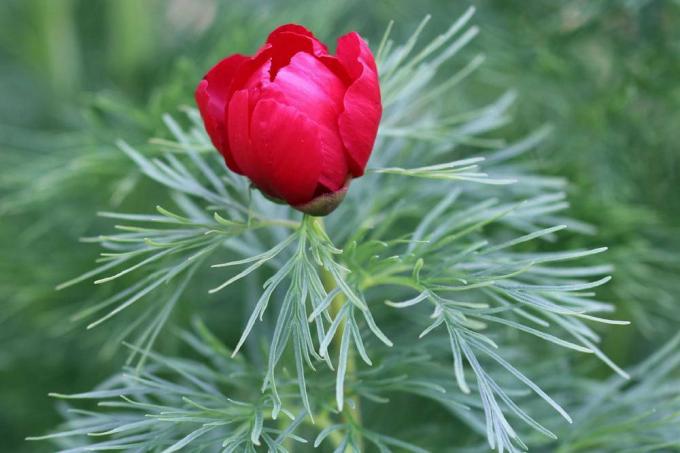
table of contents
- Location
- care
- to water
- Fertilize
- plants
- Cut
- Overwinter
- Multiply
- Diseases
Profile and care information open +conclude -
- Flower color
- Red
- Location
- Partial shade, shady, sunny
- Heyday
- May June
- Growth habit
- upright, expansive, bushy, clump-forming
- height
- up to 50 centimeters high
- Soil type
- sandy, loamy, clayey
- Soil moisture
- moderately dry, fresh
- PH value
- weakly acidic
- Limescale tolerance
- k. A.
- humus
- k. A.
- Poisonous
- Yes
- Plant families
- Peony Family, Paeoniaceae
- Plant species
- Garden shrubs, ornamental shrubs, flowering shrubs
- Garden style
- Cottage garden, cottage garden, flower garden
The net leaf peony is a special representative of its kind. It is the only peony with finely divided leaves. Its bright red leaves are a feast for the eyes in the garden between May and June and give it a romantic flair. The narrow-leaved peony is a robust plant that can be left to its own devices in summer. A few special needs have to be met in order to cultivate the rarity from Southeast Europe in our gardens for many years.
Location
Choose the right location
Paeonia tenuifolia is attractive and eye-catching. With its purple flowers and bright yellow anthers, the ornamental plant is anything but inconspicuous. The net leaf peony is a sun worshiper that can reach a maximum height of 50 cm.

Your demands on the location are high:
- sunny
- sheltered from the wind
- warm
The plant can cope with a partially shaded place if there are many hours of sunshine in the morning or afternoon. The peony belongs to the type of plant that not only cares in a shady place, but does not sprout in the first place. In their original home of the beauty of plants, which is in Asia Minor and Southeast Europe, the ornamental plant can be found on dry meadows. In the home garden, these conditions can be optimally fulfilled in rock gardens. The location must meet the light requirements of the reticulated peony.
care
Another important point that promotes the growth of the perennial: The perennial cannot tolerate root pressure. Young specimens of Paeonia tenuifolia are sensitive to their neighbors, which, with their network of dense roots, encourage the growth of the Peonies hinder. For underplanting trees or The exotic plants are only partially suitable for shrubs.
It is advisable to keep a minimum distance of 50 cm between the peonies. Avoid planted neighborhoods that have a flat root network if possible. Peonies are true to location. If the plants can develop in the right place, they are indestructible and robust. The plants are unsuitable for planting in a tub.
Substrate
The correct soil ratio is a relevant point in the care of the robust plants. If you want to buy a peony, you should create the following substrate conditions in the garden.
- permeable and profound
- loamy-humos
- slight sand content

A strongly compacted soil reduces the growth and the formation of roots of the plant with the net-like, finely slotted leaves. To make your work easier, small stones can be worked into the ground here. The material loosens the soil permanently. At the same time, rainwater and irrigation water can seep into the substrate more quickly. Reticulated peonies don't like wet feet.
to water
Paeonia tenuifolia is an extraordinary peony. It is the only peony with finely divided leaves. The individual segments of the leaves are a maximum of 2 mm wide. As a representative of the Eastern European steppes, the perennial plant is robust. Nevertheless, the reticulated peony needs the right care to develop its colorful, eye-catching flowers.
Short-term drought cannot harm the crop. It looks different with waterlogging. This favors the infestation of hose fungi. These pathogens cause the root rot that is feared by gardeners. At an advanced stage, this inevitably leads to the death of the affected plants.
As with almost all perennials, the root ball of the narrow-leaved peony should not dry out completely. On hot days it makes sense to check the moisture content of the substrate.
- water in the morning and late afternoon
- Use lime-free water
- Regularly provide young and flowering plants with water

Watering during lunchtime, when the sun is beating directly on the leaves and shoots, stresses the dill peony. There is a high risk that much of the valuable liquid will evaporate too quickly. Bark mulch is a good material to bind moisture in the soil. It fulfills various tasks and, among other things, ensures that the evaporation rate remains low.
Fertilize
The unwooded, perennial peony species is frugal. This is also reflected in the nutrient consumption. When the beds are mulched in spring and compost or If horn shavings are spread, the peony has nothing against a good dose of fertilizer. Nutrients must be added to the substrate at least every two years, otherwise the growth of the plant will stagnate. If you want to use products from the trade, you should buy a conventional slow release fertilizer. This is used shortly before flowering.
plants
Planting in the garden
Fall is the ideal time to plant reticulated peonies.
Follow these steps:
- the planting hole must be twice as large as the root ball of the peony
- Loosen the surrounding soil sufficiently with a digging fork
- Spread compost at the bottom of the hole
- prepare the substrate
- if necessary, loosen with fine pebbles
- Insert the plant
- Fill back the soil and press it down
- pour on firmly
Paeonia tenuifolia belongs to the perennial peonies. There is a special feature when replanting this species: the buds of the root stock may only be buried a maximum of 5 cm deep. If the buds are too deep in the ground, the plant will not flower. Soil fatigue is also an issue that should not be underestimated when it comes to the reticulated peony.

If the plant has to change its planting location, no other peonies should be planted in this place for 3 to 4 years. Subsequent plants of the same genus take care and are extremely susceptible to disease. Adequate fertilization will not correct this problem. If anything, the only thing that helps is a generous replacement of the old substrate.
Peonies in the bucket
Perennial peonies are deep-rooted. In the search for nutrients and water, the taproots of older perennials can grow to a length of over 2 m. Hardly any conventional planter can do this justice. Young shrub peonies can be cultivated in the tub for a limited period of time. One hopes in vain for a bloom here. When planted in pots, the plant makes the same demands on the gardener as in the field.
- The substrate should be sandy
- Drainage on the bottom of the bucket prevents waterlogging
- the planting location must be light and warm
In the following year at the latest, the reticulated peony should move to its final place in the garden. Potted plants are fertilized with liquid fertilizer.
Cut
The longevity of the peony should not be underestimated. The beautiful spring bloomers can reach a stately age of 100 years. Provided that the requirements for the planting location are sufficiently met. Like all shrub peonies, the dill peony retreats into the ground in winter.
The above-ground shoots wither shortly after flowering. In late autumn, the withered shoots are cut to about 10 centimeters above the ground. This prevents a fungal attack in the following year.
Other helpful tips to encourage the shrub peony to develop:
- Remove dead flowers immediately
- Cut frozen shoots in spring
- the stem of the peony must not be crushed
In order not to unnecessarily promote diseases, the pruning measure is carried out on a dry, sunny day. Preferably in the early morning. What many hobby gardeners do not know: The net leaf peony makes a distinctive vase ornament. To do this, the flowering shoots are cut, the lower leaves on the stems should be removed immediately.
- shorten the stem every 2 days
- change the water regularly
- The vase should be in a bright place without drafts
Overwinter
Paeonia tenuifolia is robust, this is particularly evident in the cold season. Due to the long tap roots, ice and snow cannot harm the reticulated peony. The plant survives temperatures in the double-digit minus range undamaged. The young shoots react more sensitively to late frosts in spring.
If you have seen the weather forecast in good time, you can cover the perennial with a fleece. The shrub-like plant has no objection to the application of bark mulch in autumn. The material warms and releases nutrients to the soil. There is no fertilization or watering in winter.
Container plants run the risk of the soil in the container completely freezing through. This can inevitably lead to the death of the fine-leaved peony. As a preventive measure, the pot is covered with a bubble wrap or Wrapped in burlap. No further precautions are necessary.
Multiply
Paeonia tenuifolia propagate
Under ideal conditions, the reticulated peony brings color to the home garden from May until well into June. The bright red flowers can be seen from a distance. These visually enchant the passionate hobby gardener and at the same time attract useful insects.
A tempting thought that one would like to multiply this extraordinary plant beauty. All peonies are demanding on this point. In addition to patience, you need a lot of tact for the propagation to work. The shrub-like ornamental plant can be propagated in three ways: by grafting, sowing and root division.

In the process of grafting, a shoot is grafted onto the roots of another shrub peony using a special cutting technique. The method is not an easy undertaking for beginners, but offers a decisive advantage over the cultivation of seeds: These plants develop their flowers after 2 or 3 years.
The fine-leaved reticulated peony should be sown outdoors. It is almost impossible to stimulate the plant to germinate in the cultivation container. Another point: It can take 16-20 months for the first shoot tips to appear. The seeds have to go through various cold and warm periods. These requirements can be met better outdoors than on the window sill.
The following tips can be used to prepare for growing seeds:
- Remove weeds, roots and stones from the bed in late summer
- plant the seeds
- press down lightly
- cover only minimally with substrate
- carefully water the soil
The sowing site should remain weed-free. This is a challenge because not every plant is immediately recognized as an undesirable crop. The longer the roots of the plants, the sooner they can displace the seeds and prevent germination. Reticulated peonies that are propagated by sowing do not bloom for about 6 years. For this reason, patience is required in many points with this type of propagation.
Propagation through root division
Older reticulated peonies can be propagated by dividing their roots. This method is laborious considering the length of the tap roots. The plant is grown in spring or Excavated in late summer.
- remove the rhizome with a sharp spade or an ax into equal pieces
- Plant the peony parts in the garden as usual
- pour vigorously and leave for approx. Keep sufficiently moist for 14 days
No further steps are required. As with previous propagation methods, the split reticulated peonies need a few years before they reliably show their abundant flowers.

Diseases
The reticulated peony is relatively hardy. Cell sap sucking insects avoid the plant. There is one disease that can afflict peonies: gray mold. These fungal spores are favored by a warm and humid spring. With shrub peonies, the entire shoots wither, with herbaceous peonies only a few buds and stems.
Paeonia tenuifolia is one of the shrubs; in the event of an infestation, the affected piece of plant is removed down to the healthy wood. The fungal pathogen can be combated effectively with special fungicides from specialist shops.

